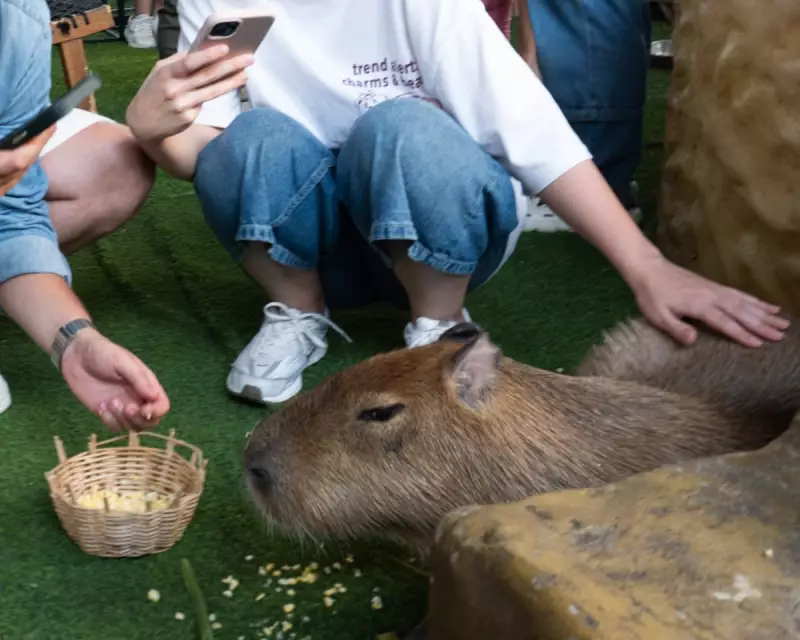
The Strange Case of Bangkok's Rodent Cafes
On the second floor of an ordinary Bangkok office building, an unusual spectacle unfolds daily. Three capybaras - the world's largest rodents - reside in a small enclosure with a shallow pool, serving as the main attraction for dozens of paying customers all eager for selfies. As visitors enthusiastically offer leafy snacks to these seemingly indifferent South American creatures, few pause to consider the fundamental question: how did these animals travel over 10,000 miles from their native habitat to this bustling Asian metropolis?
Internet Fame Drives Exotic Cafe Expansion
The proliferation of capybara cafes across Asia represents a growing trend driven by the animal's surging online popularity. These semi-aquatic mammals feature in more than 600,000 TikTok posts, fueling consumer interest in close encounters. At the Bangkok establishment, customers pay 400 baht (£9.40) for a 30-minute petting session that includes not just capybaras but also meerkats and Chinese bamboo rats. The cafe operates 12 hours daily, seven days a week.
Elizabeth Congdon, a capybara biologist at Bethune-Cookman University in Florida, reflects on the animal's sudden appeal: "They're just so weird. And then you combine that weirdness factor with how docile they are, how easy they are to keep in zoos, and how social they are."
Troubling Connection to Illegal Wildlife Trade
This newfound popularity connects to a disturbing expansion of exotic animal cafes throughout Asia. While Taiwan pioneered the concept with cat cafes in 1998, and Japan and South Korea later introduced establishments featuring owls, raccoons and otters, the industry has taken a concerning turn. Last year, South Korea implemented laws requiring cafes displaying wild animals to register as zoos or aquariums, but other Asian cities including Ho Chi Minh in Vietnam and Guangzhou in China continue to experience growing demand.
Timothy Bonebrake, a conservation biologist at the University of Hong Kong who has studied this phenomenon, states: "The amount of diversity and the number of animals - and, in particular, quite a few threatened animals - is very concerning."
Online searches readily reveal capybara cafes in Jakarta, Qingdao, and Hanoi. Although capybaras aren't classified as endangered - with approximately 1.2 million roaming Brazil's wetlands and cities - their international movement raises serious questions. The Convention on International Trade in Endangered Species of Wild Fauna and Flora (Cites) doesn't regulate capybara trade, though exporting native wild capybaras remains illegal in many South American nations including Brazil, Argentina and Peru.
Scott Roberton, executive director of a team countering wildlife trafficking at the Wildlife Conservation Society (WCS), explains: "Legal and illegal supply chains for live animals converge at multiple points, and are often controlled by the same people and companies."
Despite claims from the Bangkok cafe that their capybaras come from "ethical farms in Thailand" rather than importation, Roberton warns that "laundering of illegally caught animals into legal supply chains is very common, with those animals often then used to establish or supplement breeding stock."
Endangered Species Caught in the Trade
The problem extends far beyond capybaras. Endangered species have become entangled in the pet trade supplying exotic animal cafes. A recent study connected small-clawed otters found in Japanese animal cafes to two poaching hotspots in southern Thailand, directly violating bans on commercial trade of this vulnerable species.
This alarming growth prompted members of the International Union for the Conservation of Nature (IUCN) to adopt a motion aimed at curbing the illegal pet trade during its October congress meeting.
Sue Lieberman, vice-president of international policy at WCS, observes: "The global pet trade is really out of control, from a conservation perspective. In the past five years, we have seen much more pet trade in Asia. We used to talk about the food trade in China, but now the pet trade in China is increasing with all these pet cafes."
Evidence supports this assessment. A survey of Qichacha, one of China's largest corporate databases, reveals the number of businesses listed as petting zoos (including animal cafes) skyrocketed from fewer than 100 in 2020 to more than 1,800 in 2025. While private pet ownership in China grew by 50% over five years, pet cafes expanded at an astonishing 200% annually.
Though comprehensive analysis of exotic animal cafe growth across Asia remains limited, a study co-authored by Bonebrake in Conservation Letters identified 406 animal cafes across Asia in 2019, with just over a quarter featuring exotic species. Among the more than 250 exotic species recorded, nearly half were threatened with extinction or had decreasing wild populations.
Broader Ecological Concerns
Beyond conservation worries about imported species, some countries express concern about exotic animals escaping and establishing invasive populations. In May, Costa Rican police seized five capybaras from traffickers, where trading these rodents is illegal precisely due to fears they could escape and thrive in the wild.
Congdon explains the risk: "Capybaras breed rapidly, can withstand a wide range of temperatures, and have a flexible diet of grasses and aquatic plants. There is a high risk for them to be invasive."
Roberton highlights another concerning aspect: the impact isn't limited to animals directly passing through cafe doors. "Suddenly, you're encouraging people that there is this cool, big exotic animal that you can pet and feed. How many people leave that cafe and go, 'I want a baby capybara'?" This stimulation of demand represents a significant secondary effect of the exotic cafe phenomenon, potentially driving further illegal wildlife trade as consumers seek to own these animals privately.





